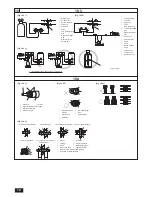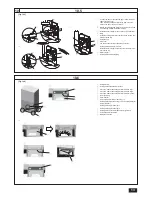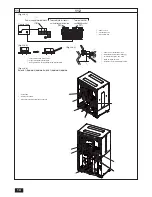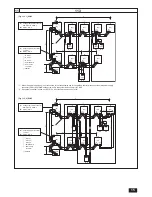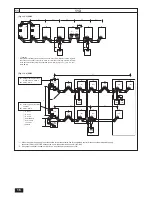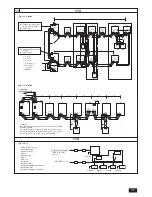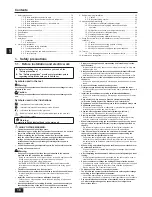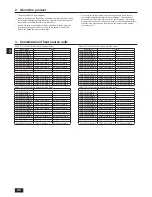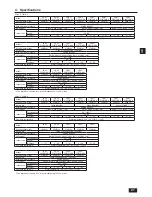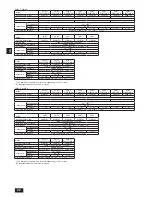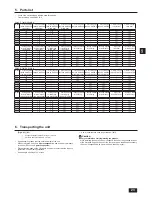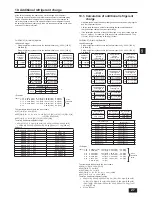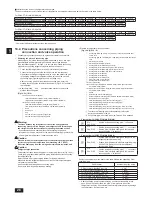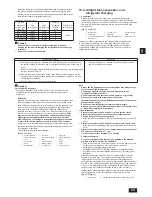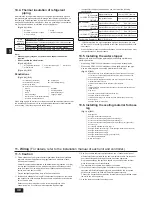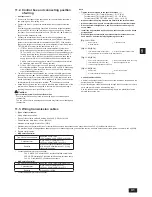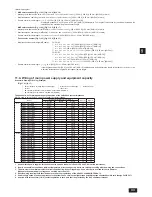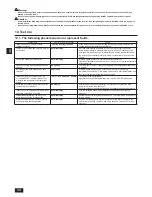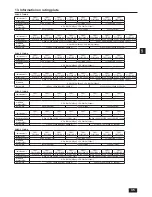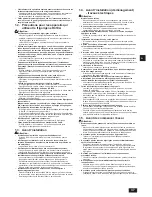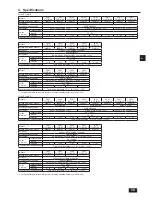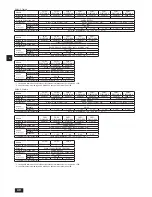
26
GB
9
A lack or an excess of refrigerant can cause the unit to stop. Charge the
system with the appropriate amount of refrigerant. When servicing, always
check the information concerning pipe length and amount of additional
refrigerant at the refrigerant volume calculation table on the back of the
service panel and the additional refrigerant section on the labels for the
combined number of indoor units (Refer to item 9.2. for detailed information
RQUHIULJHUDQWSLSLQJV\VWHP
0
Charge the system using liquid refrigerant.
a
Never use refrigerant to air purge.
Always evacuate using a vacuum
pump.
b
$OZD\VLQVXODWHWKHSLSLQJSURSHUO\,QVXI¿FLHQWLQVXODWLRQZLOOUHVXOWLQ
a decline in heating/cooling performance, condensation and other such
SUREOHPV5HIHUWRLWHPIRULQVXODWLRQRIWKHUHIULJHUDQWSLSLQJ
c
When connecting the refrigerant piping, make sure the valve of the heat
VRXUFHXQLWLVFRPSOHWHO\FORVHGWKHIDFWRU\VHWWLQJDQGGRQRWRSHUDWH
it until the refrigerant piping for the heat source unit, indoor units and
BC controller has been connected, a refrigerant leakage test has been
performed, and the evacuation process has been completed.
d
Braze only with non-oxided material. Failure to do so may damage the
compressor. Braze using nitrogen purge.
Do not use any commercially available anti-oxidizing agent, because it
may cause pipe corrosion and degrade the refrigerant oil.
Contact Mitsubishi Electric for more details.
5HIHUWRLWHPIRUGHWDLOVRIWKHSLSLQJFRQQHFWLRQDQGYDOYHRSHUDWLRQ
e
Never perform piping connections when raining.
Warning:
When installing and relocating the unit, do not charge the system with any
RWKHUUHIULJHUDQWRWKHUWKDQZKDWLVVSHFL¿HG
- Mixing different refrigerant, air, etc. may cause the refrigerant cycle to
malfunction and result in severe damage.
Caution:
8VHDYDFXXPSXPSZLWKDUHYHUVHÀRZFKHFNYDOYH
,IWKHYDFXXPSXPSGRHVQRWKDYHDUHYHUVHÀRZFKHFNYDOYHWKHYDFXXP
SXPSRLOPD\ÀRZEDFNLQWRWKHUHIULJHUDQWF\FOHDQGFDXVHGHWHULRUDWLRQRI
the refrigerant oil.
Do not use the tools shown below used with conventional refrigerant.
(Gauge manifold, charge hose, gas leak detector, check valve,
refrigerant charge base, vacuum gauge, refrigerant recovery
equipment)
- Mixing of conventional refrigerant and refrigerant oil may cause the
refrigerant oil to deteriorate.
- Mixing of water will cause the refrigerant oil to deteriorate.
- R410A refrigerant does not contain any chlorine. Therefore, gas leak
detectors for conventional refrigerants will not react to it.
Manage tools used for R410A carefully.
- If dust, dirt, or water gets in the refrigerant cycle, the refrigerant oil will
deteriorate.
Never use existing refrigerant piping.
- The large amount of chlorine in conventional refrigerant and refrigerant oil
in existing piping will cause the new refrigerant to deteriorate.
Store the piping to be used during installation indoors and keep both
ends of the piping sealed until just before brazing.
- If dust, dirt, or water get into the refrigerant cycle, the oil will deteriorate
and the compressor may fail.
Do not use a charging cylinder.
- Using a charging cylinder may cause the refrigerant to deteriorate.
Do not use special detergents to wash the piping.
9.2. Refrigerant piping system
Example of refrigerant piping system
[Fig. 9.2.1]
(P.4, P.6 - 7)
Heat source model
Liquid side
Gas side
Total capacity of indoor units
Liquid pipe
Gas pipe
Model number
Downstream unit model total
7KH¿UVWEUDQFKRI3a3
7KH¿UVWEUDQFKRI3a3
Joint
4-Branch header
'RZQVWUHDPLQGRRUXQLWPRGHOWRWDO
8-Branch header (Downstream indoor
XQLWPRGHOWRWDO
10-Branch header (Downstream indoor
XQLWPRGHOWRWDO
Heat source twinning kit
A
Heat source unit
B
1st branch
C
Indoor unit
D
Cap
E
Heat source twinning kit
F
Header
*1 ø12.7 for over 90 m [295-1/4in]
*2 ø12.7 for over 40 m [131-3/16in]
*3 The pipe sizes listed in columns A1 to A2 in this table correspond to the sizes
for the models listed in the unit 1 and 2 columns. When the order of the models
for unit 1 and 2 change, make sure to use the appropriate pipe size.
*4
B
,IWKHSLSLQJOHQJWKDIWHUWKH¿UVWMRLQWH[FHHGVPPXVHWKHRQH
VL]HODUJHUOLTXLGSLSHIRUWKHLQGRRUXQ<3ā76/08$<6/08$
*5
C
When the height difference between the indoor units is 15 m or greater
PXVHWKHRQHVL]HODUJHUOLTXLGSLSHIRUWKHLQGRRUXQLWORZHUVLGHIRU
34+<3ā76/08$<6/08$
[Fig. 9.2.2]
(P.5 - 7)
Heat source model
High-pressure side
Low-pressure side
Total capacity of indoor units
Liquid pipe
Gas pipe
Model number
Downstream unit model total
Heat source twinning kit
High-pressure gas pipe
Low-pressure gas pipe
A
Heat source unit
B
%&FRQWUROOHUVWDQGDUG
C
%&FRQWUROOHUPDLQ
D
%&FRQWUROOHUVXE
E
,QGRRUXQLWa
F
,QGRRUXQLWa
G
Heat source twinning kit
*1 When the piping length is 65 m or longer, use the ø28.58 [1-1/8] pipe for the
part that exceeds 65 m.
*2 The pipe sizes listed in columns A1 to A2 in this table correspond to the sizes
for the models listed in the unit 1 and 2 columns. When the order of unit 1 and
2 is changed, make sure to use the appropriate pipe size for the model.
Precautions for heat source unit combinations
Refer to [Fig. 9.2.3] for the positioning of twinning pipes.
[Fig. 9.2.3]
(P.8)
<A>
:KHQWKHSLSLQJIURPWKHWZLQQLQJSLSHH[FHHGVP>IW@LQFOXGHDWUDS
JDVSLSHRQO\ZLWKLQP>IW@0DNHVXUHWKHKHLJKWRIWKHWUDSLVPP
[7-7/8 in] or more.
If there is no trap, oil can accumulate inside the pipe, causing a shortage of
RLOGDPDJLQJWKHFRPSUHVV<3ā76/08$<6/08$
<B>
([DPSOHRISLSLQJFRQQHFWL<3ā76/08$<6/08$
A
Indoor unit
B
7UDSJDVSLSHRQO\
C
Within 2 m [6 ft]
D
Twinning pipe
E
Field-supplied piping
F
Twinning kit
G
Straight pipe length that is 500 mm [19-11/16 in] or more
Precautions for heat source unit combinations
Refer to [Fig. 9.2.4] for the positioning of twinning pipes.
[Fig. 9.2.4]
(P.8 - 9)
<A> Install the piping so that oil will not accumulate in the stopped heat source
unit. (both the liquid and the gas side for PQHY-P·TSLMU-A/YSLMU-A, the
KLJKSUHVVXUHVLGHRQO\IRU345<3ā76/08$<6/08$
1.
The NG example shows that oil accumulates because the units are installed
on a reverse gradient while unit 1 is in operation, and unit 2 is stopped.
2.
The NG example shows that oil accumulates into unit 1 while unit 2 is in
RSHUDWLRQDQGXQLWLVVWRSSHG9HUWLFDOSLSHKHLJKWKVKRXOGEHP
LQRUEHORZ
3.
The NG example shows that oil accumulates into unit 1 while unit 2 is in
RSHUDWLRQDQGXQLWLVVWRSSHG9HUWLFDOSLSHKHLJKWKVKRXOGEHP
LQRUEHORZ
4.
The NG example shows that oil accumulates into unit 2 while unit 1 is in
RSHUDWLRQDQGXQLWLVVWRSSHG9HUWLFDOSLSHKHLJKWKVKRXOGEHP
LQRUEHORZ
<B>
6ORSHRIWZLQQLQJSLS<3ā76/08$<6/08$
Make sure the slope of the twinning pipes are at an angle within ±15° to the
horizontal plane.
,IWKHVORSHH[FHHGVWKHDQJOHVSHFL¿HGWKHXQLWPD\EHGDPDJHG
<C>
([DPSOHRISLSLQJFRQQHFWLRQIRU345<3ā76/08$<6/08$
A
Slope downward
B
Slope upward
C
%&FRQWUROOHUVWDQGDUGRUPDLQ
D
Twinning pipe
E
Slope of the twinning pipe is at an angle within ±15° to the ground
F
7ZLQQLQJSLSHORZSUHVVXUHVLGH
G
7ZLQQLQJSLSHKLJKSUHVVXUHVLGH
H
Field-supplied piping (low-pressure connecting pipe: between heat source
XQLWV
I
)LHOGVXSSOLHGSLSLQJORZSUHVVXUHPDLQSLSHWR%&FRQWUROOHU
J
)LHOGVXSSOLHGSLSLQJKLJKSUHVVXUHPDLQSLSHWR%&FRQWUROOHU
Caution:
'RQRWLQVWDOOWUDSVWRSUHYHQWRLOEDFNÀRZDQGFRPSUHVVRUVWDUWXS
failure.
'RQRWLQVWDOOVROHQRLGYDOYHVWRSUHYHQWRLOEDFNÀRZDQGFRPSUHVVRU
start-up failure.
Do not install a sight glass because it may show improper refrigerant
ÀRZ
If a sight glass is installed, inexperienced technicians that use the
glass may overcharge the refrigerant.
Summary of Contents for CITY MULTI PQHY-P-TLMU-A
Page 55: ......

